-
Paper Information
- Paper Submission
-
Journal Information
- About This Journal
- Editorial Board
- Current Issue
- Archive
- Author Guidelines
- Contact Us
Geosciences
p-ISSN: 2163-1697 e-ISSN: 2163-1719
2017; 7(2): 68-76
doi:10.5923/j.geo.20170702.03

A Slipping and Buried Strike-Slip Fault in a Multi-Layered Elastic Model
1Udairampur Pallisree Sikshayatan (H.S.), Udairampur, P.O. Kanyanagar, Pin, India
2Department of Applied Mathematics, University of Calcutta, Calcutta, India
Correspondence to: Asish Karmakar, Udairampur Pallisree Sikshayatan (H.S.), Udairampur, P.O. Kanyanagar, Pin, India.
| Email: |  |
Copyright © 2017 Scientific & Academic Publishing. All Rights Reserved.
This work is licensed under the Creative Commons Attribution International License (CC BY).
http://creativecommons.org/licenses/by/4.0/

Modeling of earthquake processes is one of the main concern in the theoretical seismology. In most of the theoretical models, which incorporate the main features of lithosphere-asthenosphere system in seismically active regions, the medium is taken to be either single or a two layered half-space, elastic or viscoelastic. But the lithosphere-asthenosphere system has many inhomogeneties with respect to their elastic properties. In view of this we consider a medium which consist of two homogeneous elastic layers overlying an elastic half-space. A buried, vertical, long, strike-slip fault is considered in the second layer. The layers and the half-space are assumed to be in welded contact. The solutions for strains and stresses, are obtained for the first layer and second layer using suitable mathematical techniques such as Green’s functions, Correspondence principle. Numerical calculations has been done by MATLAB.
Keywords: Strike-slip fault, Green’s functions, Elastic layers, Lithosphere-asthenosphere system
Cite this paper: Asish Karmakar, Sanjay Sen, A Slipping and Buried Strike-Slip Fault in a Multi-Layered Elastic Model, Geosciences, Vol. 7 No. 2, 2017, pp. 68-76. doi: 10.5923/j.geo.20170702.03.
Article Outline
1. Introduction
- Earthquake occurs in a cyclic order. From regular observations it is known that two major seismic events are usually separated by a comparatively long aseismic period. In this aseismic period observations show slow surface movements, indicating a slow aseismic change of stress and strain in the vicinity of the fault. In this paper we developed a theoretical model of lithosphere-asthenospohere system represented by three layered elastic half-space. Such theoretical models was considered by Sato [1], Rybicki [2, 3], Mukhopadhyay [4, 5], Mukherjee [6], Sen and Debnath, [7], Debnath and Sen [8-10], Debnath and Sen [11-13], Mondal and Sen [14].
2. Formulation
- We consider a theoretical model of lithosphere-asthenosphere system consisting of two elastic layers and a elastic half-space. The layers and half-space are assumed to be in welded contact. The depth of the boundaries of two layers from free surface is taken as
 and second layer and half-space as
and second layer and half-space as  We consider a buried vertical strike-slip fault situated in the second layer and the length of the fault is very large compare to its width
We consider a buried vertical strike-slip fault situated in the second layer and the length of the fault is very large compare to its width  The depth of the upper edge of the fault below the boundary of two layers is
The depth of the upper edge of the fault below the boundary of two layers is  and upper and lower edges of the fault are horizontal. We introduce a rectangular Cartesian co-ordinate system
and upper and lower edges of the fault are horizontal. We introduce a rectangular Cartesian co-ordinate system  with the plane free surface as the plane
with the plane free surface as the plane 
 is taken vertically downwards in the medium,
is taken vertically downwards in the medium,  is taken along the strike of the fault on the free surface.The boundaries between two layers and second layers and half-space are given by
is taken along the strike of the fault on the free surface.The boundaries between two layers and second layers and half-space are given by  respectively. For convenience of analysis we introduce another set of Cartesian co-ordinate system
respectively. For convenience of analysis we introduce another set of Cartesian co-ordinate system  with the upper edge of the fault is taken as
with the upper edge of the fault is taken as  and the plane of the fault is taken as the plane
and the plane of the fault is taken as the plane  so that the fault is given by
so that the fault is given by  . The relations between two co-ordinate system are given by
. The relations between two co-ordinate system are given by | (1) |
 and
and  respectively. The Figure 1 shows the section of the theoretical model by the plane
respectively. The Figure 1 shows the section of the theoretical model by the plane  It is assumed that the length of the faults are large compared to their depths. So the displacements, stresses and strains are independent of
It is assumed that the length of the faults are large compared to their depths. So the displacements, stresses and strains are independent of  and depend only on
and depend only on  Then the components of displacement, stress and strain can be divided into two groups, one associated with strike-slip movement and another associated with dip-slip movement of the fault. Since in this model the strike-slip movement of the fault is considered, then the displacement, stress and strain components associated with long strike-slip fault for two layers and half-space are
Then the components of displacement, stress and strain can be divided into two groups, one associated with strike-slip movement and another associated with dip-slip movement of the fault. Since in this model the strike-slip movement of the fault is considered, then the displacement, stress and strain components associated with long strike-slip fault for two layers and half-space are 
 and
and  respectively.
respectively. | Figure 1. Section of the model by the plane  |
2.1. Constitutive Equations (Stress-Strain Relations)
- For the first elastic layer, the stress-strain relation can be written in the following form:
 | (2) |
 is the rigidity of the first elastic layer.For the second elastic layer, the stress-strain relation can be written in the following form:
is the rigidity of the first elastic layer.For the second elastic layer, the stress-strain relation can be written in the following form: | (3) |
 is the rigidity of the second elastic layer.For half-space, the stress-strain relation can be written in the following form:
is the rigidity of the second elastic layer.For half-space, the stress-strain relation can be written in the following form: | (4) |
 are rigidity of the half-space.The rigidities
are rigidity of the half-space.The rigidities  of the elastic layers and half-space are assumed to be constant.
of the elastic layers and half-space are assumed to be constant. 2.2. Stress Equation of Motion
- For a slow, aseismic, quasi-static deformation the magnitude of the inertial terms are very small compared to the other terms in the stress equation of motion and they can be neglected. Hence relevant stress satisfy the relations:
 | (5) |

 | (6) |

 | (7) |
 From equation (2)-(7) we get
From equation (2)-(7) we get | (8) |
 | (9) |
 | (10) |
2.3. Boundary Conditions
- We assume that the upper surface of the first elastic layer is stress-free and the two layers and the second layer and half-space are assumed to be in welded contact. Then the boundary conditions are given below
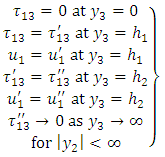 | (11) |
2.4. Initial Conditions
- We assume that the time t is measured from a suitable instant when the model is in aseismic state and there is no seismic disturbance in it.
 are the values of
are the values of  at time
at time  and they satisfy all the relations stated above.
and they satisfy all the relations stated above.2.5. Conditions at Infinity
- At a large distance from the fault plane there is a shear strain which may changes with time maintained by the tectonic forces. Then
 | (12) |
 | (13) |
 | (14) |

 where
where  are the values of
are the values of  at time
at time  In the medium of lithosphere-asthenosphere the layers and half-space are in welded contact, same
In the medium of lithosphere-asthenosphere the layers and half-space are in welded contact, same  has been taken for each layer and half-space, since strains are continuous at the boundaries of layers. From the major earthquakes it has been observed that the stresses release may be of the order of 400 bars. Keeping this in view, if we take
has been taken for each layer and half-space, since strains are continuous at the boundaries of layers. From the major earthquakes it has been observed that the stresses release may be of the order of 400 bars. Keeping this in view, if we take  to be linearly increasing function of time t with
to be linearly increasing function of time t with  If we take
If we take  then the value of
then the value of  should be of the order of
should be of the order of 
3. Displacements, Stresses and Strains in the Absence of Fault Movement
- To obtain the solution for displacements, stresses and strains in the absence of fault movement we solve the boundary value problem (2)-(14) and get the solution in the following form:
 | (15) |
 | (16) |
 | (17) |
4. Displacements, Stresses and Strains after the Restoration of Aseismic State Following a Sudden Strike-Slip Movement across the Fault
- It is to be noted that due to a sudden fault movement across the fault
 the accumulated stress will be released to some extent and the fault becomes locked again when the shear stress near the fault has sufficiently been released. The disturbance generated due to this sudden slip across the fault
the accumulated stress will be released to some extent and the fault becomes locked again when the shear stress near the fault has sufficiently been released. The disturbance generated due to this sudden slip across the fault  will gradually die out within a short span of time. During this short period, the inertia terms can not be neglected, so that our basic equations are no longer valid. We leave out this short span of time from our consideration and consider the model afresh from a suitable instant when the aseismic state re-established in the model. We determine the displacements, stresses and strains after the fault movement with respect to new time origin
will gradually die out within a short span of time. During this short period, the inertia terms can not be neglected, so that our basic equations are no longer valid. We leave out this short span of time from our consideration and consider the model afresh from a suitable instant when the aseismic state re-established in the model. We determine the displacements, stresses and strains after the fault movement with respect to new time origin  So that all the equations (2)-(14) are also valid.The sudden movement across
So that all the equations (2)-(14) are also valid.The sudden movement across  is characterized by the discontinuity of
is characterized by the discontinuity of  across
across  is defined as
is defined as | (18) |
 and
and  is a continuous function of
is a continuous function of  and U is constant, independent of
and U is constant, independent of  and
and  . All the other components
. All the other components  are continuous everywhere in the medium.We try to obtain the displacements stresses for
are continuous everywhere in the medium.We try to obtain the displacements stresses for  (with respect to new time origin) due to the movement across F in the following form:
(with respect to new time origin) due to the movement across F in the following form: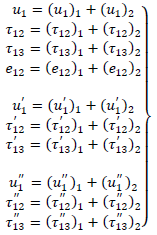 | (19) |
 satisfy all the equations (2)-(14) and continuous throughout the medium. While
satisfy all the equations (2)-(14) and continuous throughout the medium. While  satisfy all the relations (2)-(11) and also the dislocation condition (18) together with
satisfy all the relations (2)-(11) and also the dislocation condition (18) together with | (20) |
 are given by
are given by 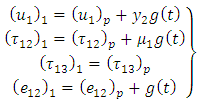 | (21) |
 | (22) |
 | (23) |
 are the values of
are the values of  respectively at
respectively at  (i.e. new time origin).Now to solve the boundary value problem containing
(i.e. new time origin).Now to solve the boundary value problem containing  we use Green’s function technique developed by Maruyama [15] and Rybicki [2, 3] as explained in Appendix. The required solutions are obtained as
we use Green’s function technique developed by Maruyama [15] and Rybicki [2, 3] as explained in Appendix. The required solutions are obtained as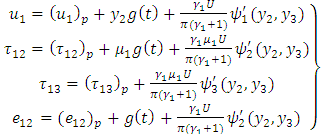 | (24) |
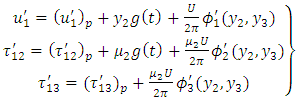 | (25) |
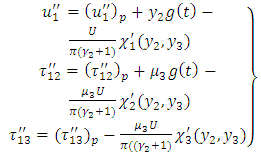 | (26) |
 and analytical form of
and analytical form of  are given in Appendix.It is found that the displacements, stresses and strains will be finite and single valued any where in the model if the following conditions are satisfied(i)
are given in Appendix.It is found that the displacements, stresses and strains will be finite and single valued any where in the model if the following conditions are satisfied(i)  and
and  are both continuous functions of
are both continuous functions of  (ii) f(0) = 0, f(l) = 0 and
(ii) f(0) = 0, f(l) = 0 and  (iii) Either
(iii) Either  is continuous in
is continuous in  or
or  is continuous in
is continuous in  except for a finite number of points of finite discontinuity in
except for a finite number of points of finite discontinuity in  is continuous in
is continuous in  except possibly for a finite number of points of finite discontinuity and for the end points of (0, l), there exist real constant m, n both < 1 such that
except possibly for a finite number of points of finite discontinuity and for the end points of (0, l), there exist real constant m, n both < 1 such that  or a finite limit as
or a finite limit as  and
and  or to a finite limit as
or to a finite limit as 
5. Numerical Computations
- To study the surface displacements, stresses and strain accumulation/ release and the shear stress near fault tending to cause strike-slip movement as we choose


 is the width of the fault
is the width of the fault 
 . from free surface, representing the upper part of the lithosphere and upper part of the asrhenosphere.
. from free surface, representing the upper part of the lithosphere and upper part of the asrhenosphere.  We take
We take  ,
,



 U = 40 cm, is the slip across F and for the function.It is assumed that due to some tectonic reason there is a slow but steady accumulation of shear strain at a distance far away from the fault. Keeping this in view we take g(t) to be linearly increasing with time and g(0) = 0. With this assumption, we take g(t) = kt. From major earthquakes it has been observed that the stress release may be of the order of 400 bars. So we assume
U = 40 cm, is the slip across F and for the function.It is assumed that due to some tectonic reason there is a slow but steady accumulation of shear strain at a distance far away from the fault. Keeping this in view we take g(t) to be linearly increasing with time and g(0) = 0. With this assumption, we take g(t) = kt. From major earthquakes it has been observed that the stress release may be of the order of 400 bars. So we assume  noting also that the observed rate of strain accumulation in seismically active regions during the aseismic period is of the order of
noting also that the observed rate of strain accumulation in seismically active regions during the aseismic period is of the order of  to
to  per year.The values of model parameters are taken from the book of Aki [16], Cathles [17], Bullen and Bolt [18] and research papers by Clift [19], Karato [20]. We now compute the following quantities(i)
per year.The values of model parameters are taken from the book of Aki [16], Cathles [17], Bullen and Bolt [18] and research papers by Clift [19], Karato [20]. We now compute the following quantities(i)  The residual/ additional surface shear strain due to fault slip near the fault after restoration of aseismic state
The residual/ additional surface shear strain due to fault slip near the fault after restoration of aseismic state (ii)
(ii)  Change in shear stress in the first layer due to fault movement.
Change in shear stress in the first layer due to fault movement. (ii)
(ii)  Change in shear stress in the second layer due to fault movement.
Change in shear stress in the second layer due to fault movement. The change in surface shear strain with
The change in surface shear strain with  near fault after restoration of aseismic state is shown in Figure 2. The figure shows that the fault movement leads to release of the surface shear strain and the effect is symmetrical about the fault trace. The magnitude of this shear strain release is maximum near fault trace and then falls off rapidly as we move away from the fault and become very small for large value of
near fault after restoration of aseismic state is shown in Figure 2. The figure shows that the fault movement leads to release of the surface shear strain and the effect is symmetrical about the fault trace. The magnitude of this shear strain release is maximum near fault trace and then falls off rapidly as we move away from the fault and become very small for large value of 
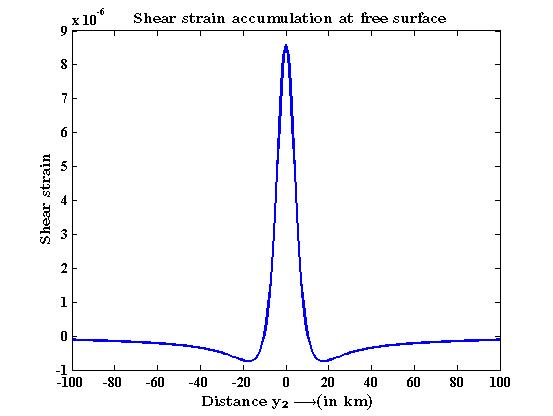 | Figure 2. Surface shear strain due to fault movement |
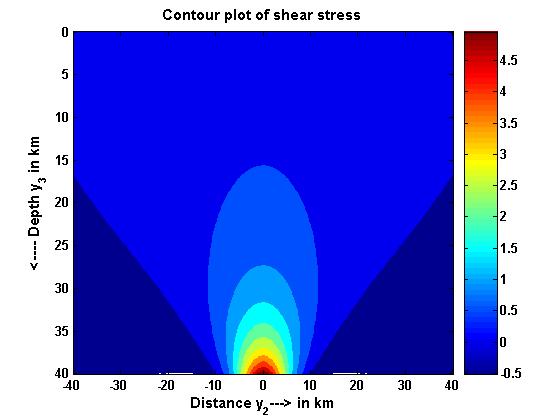 | Figure 3. Contour map of shear stress in the first layer |
 | Figure 4. Contour map of shear stress in the second layer |
6. Conclusions
- It is observed that the movement across the fault system significantly effect the nature of stress accumulation in the region. The rate of accumulation of stress in the system after the fault movement may give us some idea about the time to the next major event. Such results may be used for the purpose of prediction of earthquakes.
ACKNOWLEDGEMENTS
- One of the authors Asish Karmakar thanks the Head Master of Udairampur Pallisree Sikshayatan (H.S.) for allowing me to pursue the research, and also thanks the Geological Survey of India; Department of Applied Mathematics, University of Calcutta for providing the library facilities.
Appendix
- Solutions of displacement, stress and strain in aseismic state after sudden movement across the fault:The displacements, stresses and strains for
 with new time origin after restoration of aseismic state followed by a sudden movement have been found in the form given by (19) where
with new time origin after restoration of aseismic state followed by a sudden movement have been found in the form given by (19) where  are given by (21)-(23) and
are given by (21)-(23) and  satisfy (2)-(11), (18) and (20). This boundary value problem involving
satisfy (2)-(11), (18) and (20). This boundary value problem involving  can be solved by using modified Green’s function technique developed by Maruyama [15] and Rybicki [3] and correspondence principle. According to them we get,
can be solved by using modified Green’s function technique developed by Maruyama [15] and Rybicki [3] and correspondence principle. According to them we get, | (A1) |
 | (A2) |
 | (A3) |
 are the field points in the first layer, second layer and half-space respectively and
are the field points in the first layer, second layer and half-space respectively and  is any point on the fault F and
is any point on the fault F and  is the magnitude of discontinuity of
is the magnitude of discontinuity of  across the fault F. According to Rybicki [3], the values of
across the fault F. According to Rybicki [3], the values of 

 are given below
are given below | (A4) |
 | (A5) |
 | (A6) |
 | (A7) |
 | (A8) |
 | (A9) |
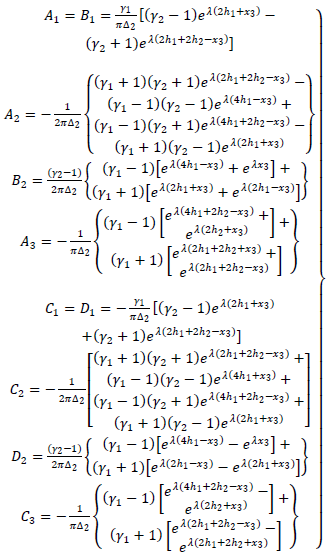 | (A10) |
 | (A11) |
 Now
Now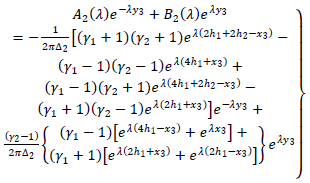 | (A12) |
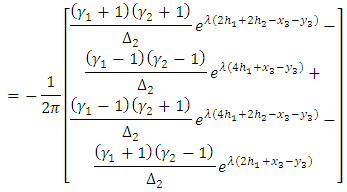 Now second part of (A12)
Now second part of (A12) Now
Now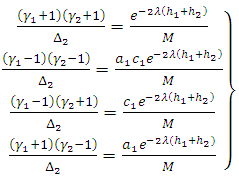 | (A13) |
 where
where  and
and  Therefore using the result of (A13), we get
Therefore using the result of (A13), we get | (A16) |

 (Mondal and Sen [14]) and we can express
(Mondal and Sen [14]) and we can express  as an infinite geometric series and neglecting the higher order term and we get from (A16)
as an infinite geometric series and neglecting the higher order term and we get from (A16)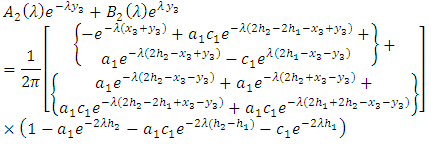 Now we assume
Now we assume 
 in the above expressions and putting this value in (A6) and after integration we get
in the above expressions and putting this value in (A6) and after integration we get | (A17) |
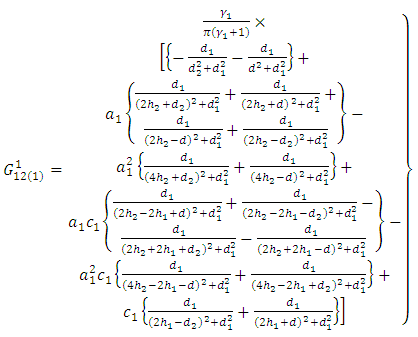 | (A18) |
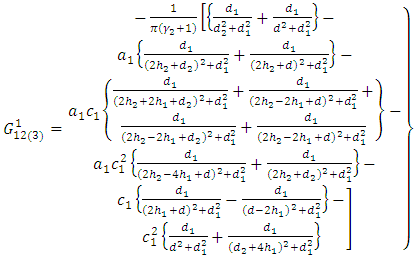 | (A19) |
 is a point on the fault F with respect to the origin O and
is a point on the fault F with respect to the origin O and  is any point on F with respect to the origin
is any point on F with respect to the origin  and a change of co-ordinate system from
and a change of co-ordinate system from  is connected by the following relations
is connected by the following relations 
 Then on the fault
Then on the fault  and
and 
 The discontinuity in
The discontinuity in  is
is  Then from (A1), (A2), (A3) we get
Then from (A1), (A2), (A3) we get | (A20) |
 | (A21) |
 | (A22) |

 Putting it in (A18), (A17), (A19) and we get the new form of
Putting it in (A18), (A17), (A19) and we get the new form of 
 Using these new form of
Using these new form of  in (A20), (A21), (A22), we get the following results
in (A20), (A21), (A22), we get the following results | (A23) |
 | (A24) |
 | (A25) |
 | (A26) |
 | (A27) |
 | (A28) |
 | (A29) |
 | (A30) |
 | (A31) |
 | (A32) |
 | (A33) |
 | (A34) |
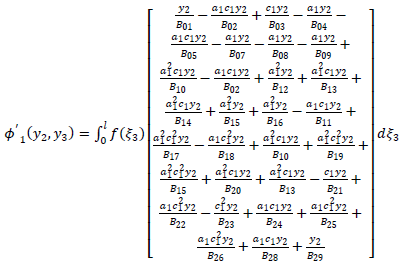 | (A35) |
 | (A36) |
 | (A37) |
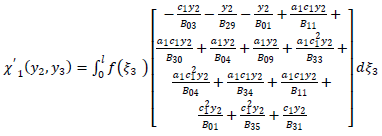 | (A38) |
 | (A39) |
 | (A40) |
 | (A41) |
 Abstract
Abstract Reference
Reference Full-Text PDF
Full-Text PDF Full-text HTML
Full-text HTML